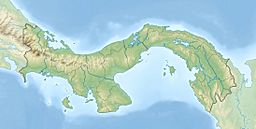Volcán Barú facts for kids
Quick facts for kids Barú |
|
|---|---|

Volcán Barú and the mountain city of Boquete
|
|
| Highest point | |
| Elevation | 3,474 m (11,398 ft) |
| Listing |
|
| Geography | |
| Country | Panama |
| Parent range | Talamanca Range |
| Geology | |
| Mountain type | Stratovolcano |
| Last eruption | 1550 ± 10 years |
The Volcán Barú (also called Volcán de Chiriquí) is an active stratovolcano and the tallest mountain in Panama. It stands 3,474 metres (11,398 ft) high. This amazing peak is about 35 km (22 mi) from the border of Costa Rica. It is also the twelfth highest mountain in all of Central America.
Because it is so tall and Panama is quite narrow, you can sometimes see both the Pacific Ocean and the Caribbean Sea from the top of Volcán Barú. This is a rare and incredible sight on a clear day!
Contents
Exploring Volcán Barú's Surroundings
The small town of Volcán sits at the base of the mountain. It is built on old mudslides from the volcano. A small river has cut through these mudslides. It shows an ancient forest that is about 1000 years old.
Volcán Barú is surrounded by rich, cool highlands. Two rivers, the Chiriquí Viejo and Caldera, flow through this area. The towns of Volcán and Cerro Punta are on the western side. The popular town of Boquete is on the eastern side.
Sometimes, hail or ice pellets fall on the summit. The temperature there can drop below 0 °C (32 °F). Frost often forms during the dry season. The peak also has many broadcast towers for TV and radio.
Understanding Volcán Barú's Activity
Scientists have studied Volcán Barú for many years. They found that it is an active volcano. It is part of the Central America Volcanic Arc, a chain of volcanoes. These studies show that the volcano's rocks formed in two main periods. Some are very old, about 20 million years. Others are much younger, even from recent times.
Volcano Safety Study
In 2006, a series of small earthquakes happened near Volcán Barú. This was not new; similar events happened in 1930, 1965, and 1985.
In 2007, the U.S. Geological Survey (USGS) worked with Panama's science groups. They published a report about Volcán Barú. This report looked at possible danger areas. It also studied the types of rocks and areas affected by past eruptions.
Scientists found proof that the last eruption was in the 16th century. During that eruption, a huge amount of rock and debris flowed down. It covered an area of 20–30 km³. This debris even reached the Pacific Ocean! It was the largest event of its kind in Central America.
What Happens During an Eruption?
Data from four past eruptions over the last 1600 years helps scientists. They think a new eruption could last several years. This would put people and buildings around the volcano at risk.
Here are some things that could happen:
- Pyroclastic flows: These are super-hot clouds of gas and ash. They move very fast down the volcano's east side. They could reach towns like Boquete and Alto Boquete.
- Ashfall: Ash and other small rocks, called tephra, would fall from the sky. This could cause fires and make roofs collapse. It might also pollute water and damage crops. Ash can also irritate eyes and lungs, especially for older people and babies.
- Lahars: These are mud and debris flows. They can cause landslides and block rivers. Lahars can have long-lasting effects on the area.
The study includes maps showing the most likely affected areas. These include Boquete, Volcán, and Bambito. The report suggests that local leaders should teach people about these risks. They should also create a plan to prepare for a possible eruption.
Volcán Barú National Park
Volcán Barú was made a national park in 1976. It is called Volcán Barú National Park. The park covers 14,325 ha (35,400 acres). It is part of the Mesoamerican Biological Corridor. This is a special area that connects natural habitats.
Amazing Animals and Plants
The park is home to many cool animals. You might see the black guan bird or the black-and-white hawk-eagle. There are also small animals like Underwood's water mouse. Birdwatchers love this park, with over 250 species identified. All five types of big cats also live here!
The park protects different kinds of forests. These include humid montane forests and montane rainforests.
Hiking Trails
One very popular hiking trail is the Sendero Los Quetzales. This trail connects Boquete with Cerro Punta. It wraps around the side of the volcano. The hike usually takes about 6 hours.
There is also a trail that goes all the way to the top of the volcano. This trail is very long, steep, and challenging. But if you make it to the summit on a clear day, you can see both the Pacific Ocean and the Caribbean Sea!
Gallery
See also
 In Spanish: Volcán Barú para niños
In Spanish: Volcán Barú para niños
- Protected areas of Panama








